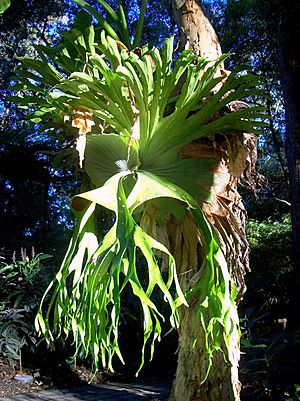Staghorn fern facts for kids
Quick facts for kids Staghorn fern |
|
|---|---|
 |
|
| Staghorn fern at North Coast Regional Botanic Garden, Australia | |
| Scientific classification |
The staghorn fern (its scientific name is Platycerium superbum) is a special type of fern. It gets its common name because its leaves look like the horns of a stag or elk! This cool plant naturally grows in Australia.
Contents
Where Staghorn Ferns Live
Staghorn ferns are originally from north-east New South Wales and Queensland in Australia. You can also find them in places like Indonesia, Malaysia, and New Guinea. People grow these ferns in many other areas, even as far south as Victoria in Australia.
In the 1990s, staghorn ferns were found growing on the Hawaiian Islands. There, they are now seen as a "problem species" because they can spread very quickly.
What Makes Staghorn Ferns Special
Platycerium superbum is a type of plant called an epiphyte. This means it grows on other plants, like trees, but it doesn't harm them. It just uses them for support. You can find these ferns naturally in rainforests. Many people also grow them in their gardens as pretty plants.
These ferns grow a special "nest" that collects humus, which is like rich soil made from decaying leaves. This nest can grow up to 1 metre wide! The ferns also have long, hanging leaves called fronds that can be up to 2 metres long.
Both the nest-forming fronds and the long, hanging fronds are wide and branch out. They really do look like the horns of a stag or elk, which is how the fern got its name.
Staghorn ferns reproduce by releasing many tiny spores. These spores float through the air and can land on nearby trees to start new plants.
How Staghorn Ferns Get Food
In the wild, the fern's "nest" acts like a basket. It catches falling leaves and other bits of plants. These materials break down and turn into nutrients that the fern can use to grow.
Staghorn ferns like soil that is a little bit acidic. If you grow one at home, some people suggest adding used tea leaves or banana peels directly to the fern's nest. This helps give the plant the nutrients it needs and keeps the soil slightly acidic.
See also
 In Spanish: Helechos cuerno de ciervo para niños
In Spanish: Helechos cuerno de ciervo para niños

